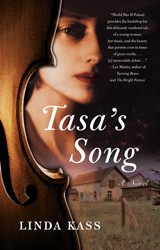Helen Maryles Shankman is the author of In the Land of Armadillos, a collection of eight stories set in Wlodawa, Poland during World War II. She is guest blogging all week as a Visiting Scribe here on The ProsenPeople.
The story materialized in my head a few days before Halloween. A gang of creatures, half-human, half-animal, attack a party of SS men executing a group of Jews. I imagined a young Jewish girl stumbling over tree roots as German soldiers herded her toward a clearing in the Polish woods. I visualized a wolf standing upright, a lean, doglike head, tip-tilted gray eyes, muscular legs encased in the trousers of a Polish military uniform.
The story thumped home with a sense of rightness. Yes, this is good. Yes, this works. All the usual signs were there; the hair raising on the back of my neck, the butterflies flitting in my stomach.
But on its heels, this: Am I trivializing the Holocaust?
My parents are Polish Holocaust survivors. Growing up, I heard the stories of their survival again and again. How my mother hid as a shepherd girl with a Polish farmer. How a Polish neighbor boy who used to play at my father’s house discovered his bunker and betrayed it to the Nazis. How my grandfather made saddles, and how the German he worked for sent a wagon to bring Zaydie and his children to his castle the day before a terrible Aktzia consumed the town.
There are so many books dedicated to Holocaust literature that readers experience a kind of overload. Yes, it was tragic, they say. Yes, millions were murdered. They’ve read Anne Frank. They’ve read Night. They’ve read Maus. They know. They know.
That’s where the challenge lay. What was different about my stories? How was I going to make World War II new again?
The facts of the catastrophe — the obsessive focus on enslavement and extermination of a peaceful civilian population, nightmarish death factories, unthinkable atrocities committed by a cultured European nation — are so impossible, so bizarre, so far-fetched, that they might as well be science fiction. I’ve been to Auschwitz and Majdanek; I’ve walked through those warehouses full of shoes and eyeglasses and hair; I’ve descended into the gas chamber and out again, and even I can’t grasp that it really happened.
 My mother’s stories of the Poles and Germans who risked their lives to save her family were just as unbelievable, the men and women bigger than life, transcending reality like characters in a fairy tale. An SS man who hid Jews in his castle, with the power to enchant his superiors; a woman who cooked such lovely breakfasts that they lured away the soldiers searching her barn; timid Torah scholars and Jewish school boys, transformed by the deep and ancient Polish forests into mighty resistance fighters. Throughout my childhood, these people loomed as large as giants. If that’s not magic, I don’t know what is.
My mother’s stories of the Poles and Germans who risked their lives to save her family were just as unbelievable, the men and women bigger than life, transcending reality like characters in a fairy tale. An SS man who hid Jews in his castle, with the power to enchant his superiors; a woman who cooked such lovely breakfasts that they lured away the soldiers searching her barn; timid Torah scholars and Jewish school boys, transformed by the deep and ancient Polish forests into mighty resistance fighters. Throughout my childhood, these people loomed as large as giants. If that’s not magic, I don’t know what is.
What made me turn to myth and magic to recount my parents’ stories? Was it the desire to control the uncontrollable? The need to believe, in a time when God’s face was hidden, that there was some guiding force behind the horror?
Art removes us to a safe distance from actual horrors, allowing us to see what we already know in a new way. Fairy tales entertain children, but they also warn them of danger. In a fable that my fictional author, Toby Rey, composes for his German protector in “In the Land of Armadillos,” he ends his allegory of a village complicit in a secret crime with this line:
“From that day forward, wherever the townspeople went, they were accompanied by the songs of birds. It filled their lives with beautiful music, but it also reminded them of what they were capable of. Remember, the songs warned them, and do not forget.”
Helen Maryles Shankman’s stories have been nominated for two Pushcart Prizes. She lives in New Jersey with her husband and four children.
Related Content:
- Interview with Gavriel Savit, author of Anna and the Swallow Man
- Margareta Ackerman: Writing About the Holocaust
- Richard Dean Rosen: Occupational Hazards and Emotional Realities in Writing About the Holocaust
Helen Maryles Shankman’s stories have been nominated for two Pushcart Prizes and have appeared in The Kenyon Review, Gargoyle, Cream City Review, 2 Bridges Review, and other publications. She lives in New Jersey with her husband and four children.




